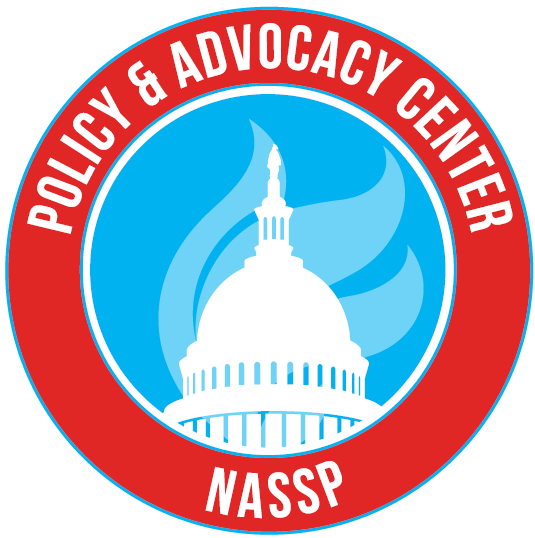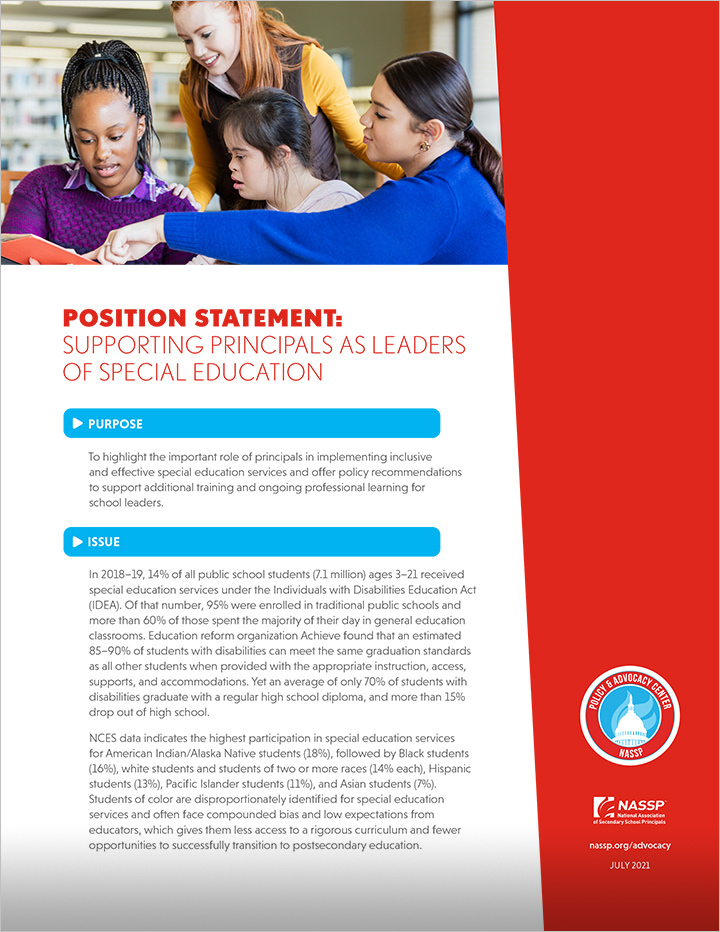
Purpose: To highlight the important role of principals in implementing inclusive and effective special education services and to offer policy recommendations to support additional training and ongoing professional learning for school leaders.
In 2018–19, 14% of all public school students (7.1 million) ages 3–21 received special education services under the Individuals with Disabilities Education Act (IDEA). Of that number, 95% were enrolled in traditional public schools and more than 60% of those spent the majority of their day in general education classrooms. Education reform organization Achieve found that an estimated 85–90% of students with disabilities can meet the same graduation standards as all other students when provided with the appropriate instruction, access, supports, and accommodations. Yet an average of only 70% of students with disabilities graduate with a regular high school diploma, and more than 15% drop out of high school.
NCES data indicates the highest participation in special education services for American Indian/Alaska Native students (18%), followed by Black students (16%), white students and students of two or more races (14% each), Hispanic students (13%), Pacific Islander students (11%), and Asian students (7%). Students of color are disproportionately identified for special education services and often face compounded bias and low expectations from educators, which gives them less access to a rigorous curriculum and fewer opportunities to successfully transition to postsecondary education.
While some progress has been made to include specific coursework, standards, or clinical experience on special education in teacher preparation, most school leaders have little or no direct experience with children with disabilities as part of their training programs. A survey of more than 3,500 principals administered through the RAND American Educator Panels found that only 12% felt “completely prepared” to support the needs of students with disabilities. The Collaboration for Effective Educator Development, Accountability, and Reform Center at the University of Florida found that only eight states required principals to receive training on special education as part of their preparation programs, and most of the coursework was focused on legal requirements rather than leading strong instructional programs for students with disabilities. Principals also report a lack of opportunities to improve their knowledge and support of special education, especially at the district level; lack of materials and other resources; and inadequate access to staff with specific expertise in the school or their district. They often must rely on school-based training to understand the intricacies of special education law and how to create inclusive learning environments for students with disabilities.
Guiding Principles
NASSP believes that principals have the power to cultivate and foster school environments where students feel safe, supported, and included, which will ensure all students can thrive.
The Professional Standards for Educational Leaders (PSEL) state that effective leaders cultivate an inclusive, caring, and supportive school community; and strive for equity of educational opportunity and culturally responsive practices that promote the academic success and well-being of each student.
Building Ranks™: A Comprehensive Framework for Effective School Leaders translates educational leadership standards into a standards-based framework that affirms the principals’ responsibility to guarantee that each person is known, valued, treated justly, and receives the individualized, high-quality education that is necessary to succeed in a global society.
NASSP has previously adopted position statements on culturally responsive schools, school discipline, promoting rigorous courses for all students, federal funding for formula and competitive grants, preparing all students for postsecondary success, and the achievement gap that offer recommendations for policymakers and school leaders to promote student equity and help each student achieve their greatest potential.
Recommendations
Recommendations for Federal Policymakers
- Fully fund Title II of the Elementary and Secondary Education Act, which can be used to strengthen school leader preparation programs and provide professional learning opportunities on multitier systems of supports and positive behavioral interventions to better support students with disabilities.
- Prioritize funding under the Higher Education Act for Transition and Postsecondary Programs for Students with Intellectual Disabilities and for partnership grants that prepare school leaders and teachers to create a culturally responsive and inclusive climate for diverse populations, including children with disabilities, English-language learners, children from low-income families, and LGBTQ+ students.
- Conduct research on the supports needed by school leaders to create inclusive schools; help them balance targeting academic, social, emotional, and physical supports for students; and connect with feeder schools and district offices to provide continuity of student care and vertical alignment of instructional practices.
- Provide technical assistance and resources to states and districts to help them incorporate best practices into their education systems.
Recommendations for State Policymakers
- Offer incentives for special education teachers or other school-based professionals with expertise in educating students with disabilities to pursue a career in school leadership.
- Adopt the PSEL to ensure that principal certification and licensure requirements include a focus on equity and cultural responsiveness; cultivation of inclusive, caring, and supportive school communities; and the knowledge necessary to meet the needs of students with disabilities.
- Ensure that principal preparation programs include coursework and aligned field experiences that educate candidates about IDEA and state laws and regulations on special education, including IEPs, what constitutes a free and appropriate public education, creating inclusive schools, monitoring student performance and special education identification and referrals, due process and mediation, least restrictive environment, the use of non-school-based services, discipline strategies and behavior management strategies, and providing professional learning for general education teachers and other school staff.
- Encourage collaboration between principal preparation programs and school districts to offer school-based learning experiences on special education such as observation of IEP meetings; focus groups and observations of special education teachers, school psychologists, and other specialized instructional support personnel; interviews with district attorneys; attendance at due process hearings; and engagement with students with disabilities and their families.
- Develop a system of principal evaluation and ongoing professional learning that focuses on successful leadership of students with disabilities and helps principals build culture and lead learning to foster lifelong success for each member of the learning community—students, educators, staff, and the broader constituencies they represent.
- Provide technical assistance and support for districts and schools on effective, inclusive school leadership.
Recommendations for District Leaders
- Ensure that principals and teachers receive training on disability identification that will help them assess their own biases, set high expectations for all students, acknowledge diverse learning styles, use linguistic and culturally responsive pedagogy, and effectively engage families of special education students.
- Provide professional learning opportunities for school leaders and other staff on the current trends in special education such as the need for school practices to align with current legal standards, creating a school climate of academic excellence through the use of schoolwide positive behavior interventions and supports, multitiered systems of support, and universal design for learning.
- Hire education professionals with expertise in special education and ensure district-level administrators provide direct support and technical assistance to school leaders on special education law and compliance requirements and leading strong instructional programs for students with disabilities.
- Integrate mental health, community, school, and family partnerships through a single system of support using an interconnected systems framework.
Recommendations for School Leaders
- Seek out professional learning opportunities and collaborate with special education teachers and other support staff to become familiar with different types of disabilities and effective instructional practices that will help ensure student success and build understanding that each student’s unique needs, regardless of their disability category, must be addressed.
- Develop a mission, vision, and core values for the school that emphasize child-centered education; high expectations and support for students with disabilities; equity, inclusiveness, and social justice; and continuous improvement.
- Implement with fidelity the universal design for learning framework along with multitiered systems of support that encompass 1) schoolwide positive behavior interventions and supports and 2) response to instruction and intervention.
- Be purposeful in hiring staff who understand and support an inclusive vision for the school, have high expectations for students with disabilities, and can work collaboratively to ensure student success.
- Ensure that all staff, students, family, and community members are educated about inequities and foster a belief that all students with disabilities can achieve when provided access to a high-quality education and appropriate accommodations and support.
- Offer opportunities for student teachers to work directly with students with disabilities and participate in IEP meetings and other family engagement opportunities.
- Develop relationships with families of students with disabilities, observe students in the classroom and other school settings, become familiar with their individual needs and abilities and be their school-based champion.
- Encourage students with disabilities to participate in student leadership opportunities and cocurricular activities.
- Advocate for full funding for IDEA; district level leadership on special education; and access to staff with expertise on supporting students with disabilities, materials, and ongoing professional learning opportunities.
Resources
Achieve (2016). Diplomas matter: Ensuring equity of opportunity for students with disabilities. Retrieved from https://nceo.umn.edu/docs/OnlinePubs/Achieve_NCEO_111616.pdf
American Association of Colleges of Teacher Education (2019). Special education tenets of clinical practice.
Bateman, D. & Bateman, F. (2014). A principal’s guide to special education. Retrieved from:
Billingsley, B., Mcleskey, J. & Crockett, J.B. (2017). Principal leadership: Moving toward inclusive and high-achieving schools for students with disabilities (Document No. IC-8). Retrieved from University of Florida, Collaboration for Effective Educator Development, Accountability, and Reform Center: https://ceedar.education.ufl.edu/wp-content/uploads/2017/12/Principal-Leadership-IC-2017-Revision.pdf
Council for Exceptional Children (2015). High-leverage practices in special education. Retrieved from https://highleveragepractices.org/store/books/high-leverage-practices-special-education
Council of Administrators of Special Education. What all principals should know about special education. Retrieved from https://www.casecec.org/books.
Council of Chief State School Officers (2017). PSEL 2015 and promoting principal leadership for the success of students with disabilities. Retrieved from https://www.ccsso.org/sites/default/files/2017-10/PSELforSWDs01252017_0.pdf
DeMatthews, D. & Brent, E. (2014). Preparing school leaders for special education: Old criticisms and new directions. Retrieved from https://scholarworks.sfasu.edu/cgi/viewcontent.cgi?article=1086&context=slr
Education Week (2018). The important role principals play in special education. Retrieved from https://www.edweek.org/teaching-learning/the-important-role-principals-play-in-special-education/2018/10
Johnston, W. & Young, C. (2019). Principal and teacher preparation to support the needs of diverse students. Retrieved from https://www.rand.org/pubs/research_reports/RR2990.html
K–12 Dive (2018). Principals a vital part of special education success. Retrieved from https://www.k12dive.com/news/principals-a-vital-part-of-special-education-success/541268/
Marek, C. (2016). Building principals’ self-efficacy regarding their ability to supervise special education programming and staff. Retrieved from https://scholarworks.gvsu.edu/cgi/viewcontent.cgi?article=1819&context=theses
National Association of Secondary School Principals (2018). Building ranks™: A comprehensive framework for effective school leaders. Reston, VA: Author.
National Association of State Directors of Special Education (2009). Principal preparedness to support students with disabilities and other diverse leaners: A policy forum proceedings document. Retrieved from https://nasdse.org/docs/87_47c6322f-36ba-4942-b51f-38e0831d2282.pdf
National Center for Education Statistics (2020). The condition of education 2020. Retrieved from https://nces.ed.gov/pubs2020/2020144.pdf
National Center for Learning Disabilities (2020). Significant disproportionality in special education: Current trends and actions for impact. Retrieved from https://www.ncld.org/sigdispro/
National Center for Learning Disabilities and Understood (2019). Forward together: A school leader’s guide to creating inclusive schools. Retrieved from https://www.ncld.org/wp-content/uploads/2019/12/Guide-to-Creating-Inclusive-Schools-12.9.2019.pdf
Stelitano, L., Johnston, W., & Young, C. (2020). Principals could use more support to help students with disabilities—especially in schools serving mostly students of color. Retrieved from https://www.rand.org/pubs/research_reports/RR2575z13.html.

